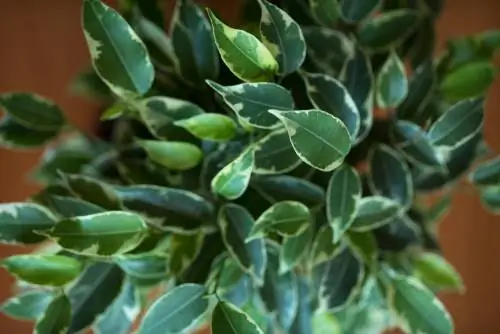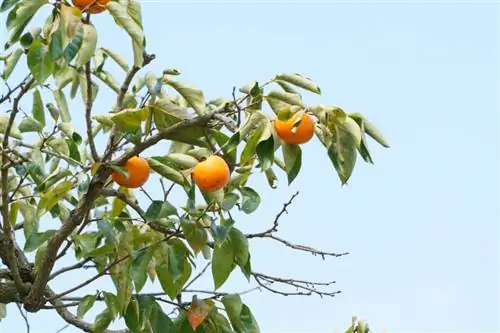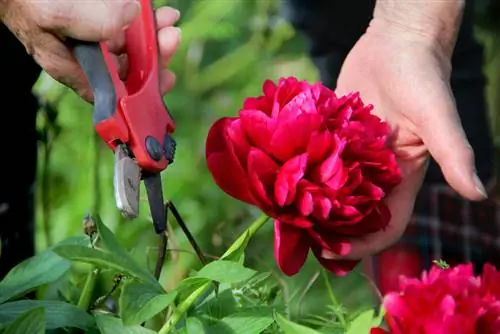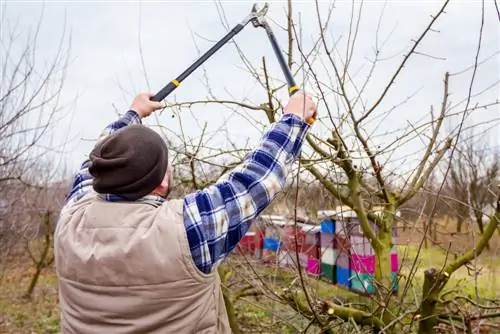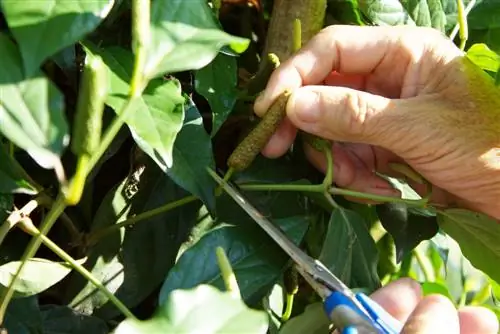- Author admin [email protected].
- Public 2023-12-16 16:46.
- Last modified 2025-06-01 06:02.
In bright, warm living rooms, Ficus Benjamini makes no secret of the fact that it would prefer to be an impressive tree. Under ideal conditions, the evergreen houseplant reaches majestic proportions that make pruning unavoidable. In this tutorial you can read when and how to prune a birch fig perfectly.
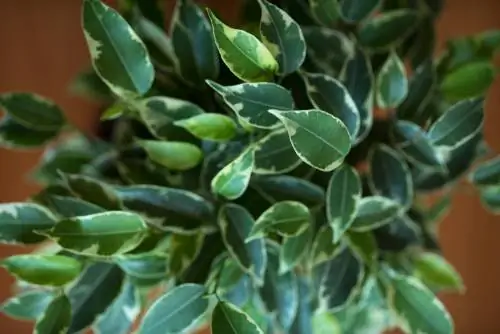
How do I cut a Ficus Benjamini correctly?
To properly prune a Ficus Benjamini, carry out a topiary in the spring by cutting back branches that are too long so that at least one leaf or bud remains on the shoot. Thinning cuts promote dense foliage, while rejuvenation cuts renew old plants.
Best time is in spring
Basically, you can prune your Ficus Benjamini at any time of the year. The evergreen indoor tree is on good terms with scissors and a saw. Even after extensive pruning, you can be confident that the plant will sprout again.
Room gardeners with a penchant forgentle pruning, take the current growth phase of your birch fig into consideration. Pruning measures are primarily considered here inlate winter or early spring. In the transition from the winter rest period to the beginning of the growing season, a Ficus Benjamini reacts to pruning with bushy, strong shoots and leaves.
Cutting compatibility allows a variety of cutting types
It is up to your horticulturist's judgment as to the extent of cutting you prescribe for your Ficus Benjamini. The pronounced pruning tolerance allows every common type of pruning, from removing individual shoots to radical rejuvenation. The following overview summarizes typical occasions for pruning birch figs:
| Cut style | Goal/Occasion |
|---|---|
| Shaping and maintenance pruning | Regulate growth height and width |
| Blending cut | promote light-flooded growth with dense foliage |
| Rejuvenation cut | rejuvenate old, oversized birch fig |
No reasonfor pruning is thedropping of leaves The common cause of the damage is an unsuitable location or care errors. If your Ficus Benjamini is forced to get rid of its beautiful leaves, pruning will not solve the problem. Please examine all cultivation conditions to identify and resolve the trigger.
Perfect in shape - topiary instructions
If a Ficus Benjamini develops into an aesthetic disruptive factor in the design of living and working spaces, a cut will bring the houseplant back into shape. Bypass secateurs are an excellent tool because they leave smooth cuts with two sharp blades. How to cut your birch fig correctly:
- Place the plant at eye level so that it can be reached from all sides
- Prune branches that are too long and out of shape
- Choose the cutting point at a distance of 2-4 millimeters from a leaf base or eye
So that a cut does not leave a gap in the foliage, at least one leaf or bud should remain on the shortened shoot. Growth continues from this growing point. Please do not cut into a bud or leave a stub that is more than 5 millimeters long. In both cases it is questionable whether the plant will sprout at this point.
In this video, the Augsburg Garden Center briefly and concisely explains how to properly cut a birch fig:

Excursus
Protect skin, clothing and floors from sticky latex
Ficus Benjamini is characterized by a sticky plant sap, which experts call latex. Aside from a viscous, sticky texture, the milky secretion contains numerous allergens. It is strongly advisable to take adequate protective measures during all cutting work. Wear gloves and long-sleeved clothing. Spread old blankets, old curtains or plastic wrap on the floor to protect against dripping latex juice. Ideally, you should move the cutting area outside onto the lawn or bare earth. You stop the flow of juice in good time with small cotton balls or paper tissues that you immediately press onto bleeding cuts.
Thinning out for a dense foliage
If a Ficus Benjamini can develop freely in height and width, it should still be cut every 2 to 3 years. At least from the age of 5 there is a risk of dead wood getting mixed in with the dense branches. As a result, buds are shaded so that they do not sprout. Baldness is spreading from the inside, spoiling a previously magnificent birch fig. This is how a thinning cut ensures a dense foliage:
- Place the birch fig where it is easily visible and accessible
- Get the folding saw and bypass secateurs ready
- Thimout dead branches
- Cut off shoots up to 3 cm in diameter
- Saw off shoots that are more than 3 cm thick
The professional cut pays attention to the astring when thinning out. On older, large birch figs you can see a bulging thickening in the transition from the branch to the trunk. Cut or saw the dead wood smoothly away from the branch ring. If there is no branch ring, make the cut just before the trunk bark.
Tip
Colorful-leaved Ficus Benjamini are very popular for creative living space design. Occasionally, monochromatic green shoots protrude from the variegated foliage. These are cheeky wild instincts that want to assert themselves. Cut out the wildlings as soon as possible because they are more vigorous and can crowd out colorful-leaved branches.
Rejuvenate old birch figs
Without the occasional thinning cut, a Ficus Benjamini will grow old and bald within a few years. If the gardener hesitates when cutting topiary, the exotic indoor tree will exceed the spatial capacity and hit the ceiling. With aradical rejuvenation cut you pave the way for a new floral beginning. How to proceed professionally:
- Put on gloves to protect yourself from the toxic latex
- Clean and disinfect the scissor blades and saw blade of the folding saw
- At the beginning, thin out all leafless, dead branches on Astring
- Cut remaining branches and trunks hand-width or up to 30 centimeters
Please note that a leafless shoot is not necessarily deadwood. Before you thin out a branch at the base, check the prospects of new shoots usingVitality Test. Use the tip of a knife to scrape the bark a little to examine the tissue. A dry, brown color indicates that it is dead wood. If fresh green tissue emerges, cut the shoot back to a hand's width or up to 30 centimeters to revitalize its sleeping eyes.
Background
Strong cut perks up sleeping buds
Radically pruning old, oversized Ficus Benjamini is a source of serious concern for beginners in pruning care. It is thanks to sleeping buds that the birch fig sprouts fresh and strong after a rejuvenation cut. This also applies when you cut into old wood. As they grow, many woody plant species wisely lay dormant buds. These vegetation points have the sole purpose of replacing lost shoots, branches or trunks. In gardening terms, the floral reserve is called sleeping eyes because they are almost invisible buds that wait beneath the bark for their wake-up call.
Frequently asked questions
Is Ficus Benjamini poisonous?
Experts classify Ficus Benjamini as slightly poisonous. The evergreen houseplant poses a he alth risk, especially to children and pets. The milky plant sap contains various toxins that, if consumed, can cause nausea, vomiting, diarrhea and circulatory problems. Cats and small rodents can die from respiratory paralysis after ingesting even small amounts of leaves. Latex allergy sufferers and sensitive adults should avoid direct skin contact with the milky sap of a birch fig because it can cause allergic reactions, such as itching, reddening of the skin and eczema.
My birch fig is covered in sticky leaves. What to do?
Sticky leaves on Ficus benjamini are more than just a cosmetic defect. The most common cause of the problem is an infestation with pests, such as aphids, which excrete viscous honeydew as a waste product. If you have discovered the tiny pests on the leaves, wipe the coating away with lukewarm, soft water. Then shower your birch fig upside down. In the final step of the treatment, spray the leaves on the top and bottom with a mixture of one liter of boiled, lukewarm water in which you have dissolved one to two tablespoons of pure soft or curd soap. A splash of spirit optimizes effectiveness. Unless you identify pests as the cause, plant sap that has escaped will stick together the leaves after pruning. Clean the leaves with a soft cloth and lime-free water.
I like to spend spring and summer on the balcony. Can I take my birch fig outside?
Staying on the light-flooded, warm balcony promotes the beauty of a birch fig. Since the exotic foliage plant cannot tolerate frost, it should only be moved outside when the temperatures are above 15 degrees Celsius day and night. To protect the shiny green leaves from sunburn, please choose a sunny to semi-shady location in a wind-protected location.
The 3 most common cutting mistakes
The good-natured pruning tolerance of Ficus Benjamini reaches its limits if important premises are not taken into account. The following overview draws attention to the three most common cutting errors and provides practical tips for prevention:
| Cutting errors | malicious image | Prevention |
|---|---|---|
| never photographed | progressive baldness from the inside out | From the 5th year onwards, thin out dead wood every 2-3 years |
| cut after leaf drop | no sprouts, risk of total failure | Do not cut when leaves fall, but optimize care |
| Wild shoots not cut out | variegated leaf decorations are overgrown with green | In variegated-leaved varieties, thin out green shoots as soon as possible |
Tip
Even without prior pruning, the birch fig benefits from a lukewarm shower. Using a plastic bag, cover the pot with root balls. Place the plant in your bathtub or shower tray. Now spray the foliage with a gentle jet of water. Twice a year you should clean the indoor tree from dust and sticky sap in this way.

